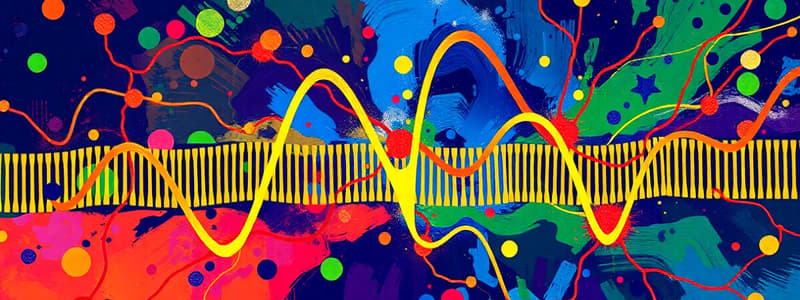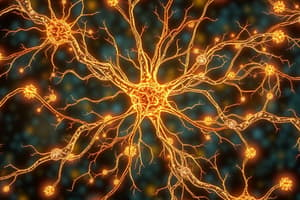Podcast
Questions and Answers
What causes the depolarization phase of the action potential?
What causes the depolarization phase of the action potential?
- Outward current of Na+ ions
- Inward current of Cl- ions
- Inward current of K+ ions
- Inward current of Na+ ions (correct)
What is the role of the threshold potential in action potentials?
What is the role of the threshold potential in action potentials?
- It indicates the point where hyperpolarization begins.
- It prevents the membrane potential from becoming positive.
- It ensures action potentials are of varying magnitudes.
- It marks the point where inward current surpasses outward current. (correct)
During the repolarization phase of the action potential, which ion conductance primarily decreases?
During the repolarization phase of the action potential, which ion conductance primarily decreases?
- Cl- conductance
- Na+ conductance (correct)
- K+ conductance
- Ca2+ conductance
What characterizes the all-or-none response of action potentials?
What characterizes the all-or-none response of action potentials?
How does hyperpolarization affect the membrane potential?
How does hyperpolarization affect the membrane potential?
What is the primary cause of repolarization during the action potential?
What is the primary cause of repolarization during the action potential?
What happens to Na+ channels shortly after activation during an action potential?
What happens to Na+ channels shortly after activation during an action potential?
During the undershoot phase of an action potential, which ion's conductance is notably higher than its resting state?
During the undershoot phase of an action potential, which ion's conductance is notably higher than its resting state?
What characterizes the absolute refractory period in relation to action potentials?
What characterizes the absolute refractory period in relation to action potentials?
How do voltage-gated K+ channels contribute to the end of the action potential?
How do voltage-gated K+ channels contribute to the end of the action potential?
Flashcards
Resting membrane potential
Resting membrane potential
The difference in electrical charge between the inside and outside of a nerve cell when it's at rest. It's typically around -70 mV.
Depolarization
Depolarization
The process where the inside of a nerve cell becomes less negative, making it more likely to fire an action potential. It's like pushing the 'go' button.
Inward current
Inward current
The movement of positive ions into the cell. It's the driving force behind depolarization, making the cell less negative.
Repolarization
Repolarization
Signup and view all the flashcards
Threshold potential
Threshold potential
Signup and view all the flashcards
Absolute Refractory Period
Absolute Refractory Period
Signup and view all the flashcards
Overshoot
Overshoot
Signup and view all the flashcards
Undershoot
Undershoot
Signup and view all the flashcards
Study Notes
Action Potential in Muscle and Nerve
- Action potential is a rapid depolarization and repolarization of the cell membrane in excitable cells (nerve and muscle).
- Depolarization: Membrane potential becomes less negative (cell interior becomes less negative).
- Hyperpolarization: Membrane potential becomes more negative (cell interior becomes more negative).
- Inward current: Flow of positive charge into the cell, depolarizes the membrane potential.
- Outward current: Flow of positive charge out of the cell, hyperpolarizes the membrane potential.
- Threshold: Membrane potential at which an action potential is inevitable. Net inward current exceeds outward current, causing self-sustaining depolarization.
- All-or-none response: If net inward current is less than outward current, no action potential occurs.
Ionic Basis of Nerve Action Potential
-
Resting membrane potential is approximately -70 mV.
-
This is due to high resting conductance to potassium (K+), driving the membrane potential toward K+ equilibrium potential.
-
At rest, sodium (Na+) channels are closed, and Na+ conductance is low.
-
Depolarization: Inward current of Na+ depolarizes the membrane potential to threshold.
-
Opening voltage-gated Na+ channels causes rapid increase in Na+ conductance, leading to a positive feedback loop.
-
Membrane potential is driven towards Na+ equilibrium potential (+65 mV), but doesn't reach it due to short-lived increase in Na+ conductance.
-
Repolarization: Na+ channels close. K+ channels open slowly and increase K+ conductance to levels higher than at rest.
-
Increased K+ conductance results in an outward current causing membrane repolarization.
-
Undershoot (hyperpolarization): K+ conductance remains higher than at rest for a period after Na+ channel closure.
-
Membrane potential is driven close to K+ equilibrium potential.
-
Voltage-gated K+ channels cause the action potential to return to resting membrane potential. (negative feedback)
Refractory Periods
- Absolute refractory period: Another action potential cannot be elicited regardless of stimulus strength, coinciding with depolarization and part of repolarization. Na+ channels are inactivated.
- Relative refractory period: Action potential can be elicited with a larger than usual inward current (after absolute refractory period). K+ conductance is high; membrane potential is close to K+ equilibrium potential.
Propagation of Action Potentials
-
Action potentials propagate by local currents to adjacent areas of the membrane, depolarizing them to threshold and generating new action potentials.
-
Conduction velocity increases with: Larger fiber diameter (less resistance), myelination (insulation).
-
Myelinated nerves exhibit saltatory conduction (action potentials jump between nodes of Ranvier).
-
Action potentials in skeletal muscle share similarities with nerve action potentials, but with quantitative differences in timing and magnitude.
Studying That Suits You
Use AI to generate personalized quizzes and flashcards to suit your learning preferences.


